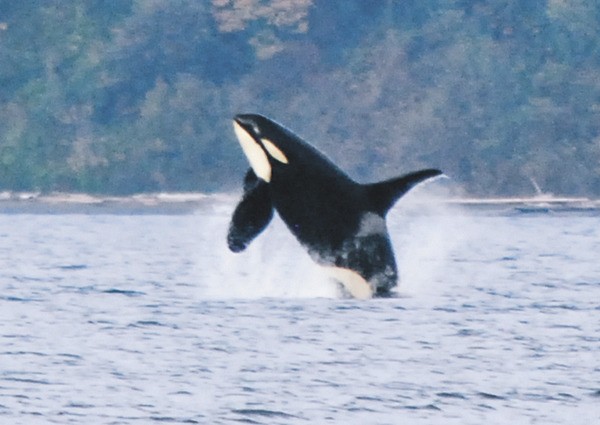Whale watching season has begun in south Puget Sound, and local experts are already predicting that large salmon runs mean it will likely be a good year for spotting orcas.
On Friday, Oct. 19, a large group of orcas from up north made their way down to Vashon, feeding on salmon as they swam south. The group, estimated to be as large as 60, eventually streamed by Point Robinson, where nearly 100 eager Islanders waited.
And the whales didn’t disappoint, slapping the water with their fins, spyhopping and breaching right off the shore.
“They were socializing quite a bit,” said Ann “Orca Annie” Stateler, who heads the Vashon Hydrophone Project and was on the beach that day.
It was the whales’ first daytime visit to Vashon this fall. They’ve skirted the Island a couple of other times during the night, a series of visits that amounts to a good showing so far for October.
Fisheries managers, Stateler said, are already seeing large numbers of chum salmon returning to local waters, and they’re predicting it will be a record year for the fish. This means killer whales might travel south more than they have in the past.
Amy Carey, director of Preserve Our Islands, agreed. While it’s not unusual to have several orca sightings in October, she said, the whales are definitely following the fish.
“The chum runs are going be very strong this year, and in those years we tend to see the whales more,” she said.
Now more than ever, whale watchers on Vashon and in the Puget Sound area are getting their information via social networking. On Oct. 19, Facebook and Twitter were aflutter with posts about the whales, especially on the popular Orca Network Facebook page, where whale watchers post nearly real-time updates of the whales’ locations.
Preserve Our Islands (POI) has made it even easier for Islanders to track whales. For a donation of $15, one can sign up to receive text messages or email alerts when the whales approach Vashon.
“There’s kind of a social network in whales,” Carey said. “An informal network of people waiting on the beach.”
Not everyone is thrilled to see new technology aid in whale watching, though. Stateler says she believes the trend may actually be harming the whales.
On the 19th, Stateler was alarmed to see some boats come closer to the whales than the legally allowed 200 yards. One boat cut right through a group of whales and “seemed totally clueless about the new rules and guidelines,” she said.
Stateler said she and fellow researcher Mark Sears believe social networking and news coverage — multiple stations broadcast footage of the orcas that day — have made it easier for people to find the whales and have resulted in more boats following them around.
Vessel traffic and boat noise are believed to have contributed to the decline in the now endangered southern resident orcas. Their population is currently at around 85, much less than the 100 to 120 considered necessary to provide a healthy amount of genetic diversity.
Stateler has observed what she calls a “strong correlation” between news coverage and Internet chatter about the whales and the number of boats following them.
“That’s not conservation, it’s exploitation,” she said.
Carey, a staunch whale conservation advocate, disagrees. Most boaters who come too close to the whales were already in the area, not people who heard about the whales and set out to find them, she said. She added that she hasn’t seen an alarming number of boats break the law.
“Never down here do we see any significant issues. People are not jumping in their boats (to see the whales),” she said.
Carey also stood by POI’s texting and emailing program. The Pod Blasts debuted last year as a pilot program because POI wanted to make sure the service wasn’t abused, she said. Only Vashon residents subscribe to the Pod Blasts, she said, and everyone has respected POI’s request that they only watch whales from the shore.
“There has never been a boat coming out because of our alerts,” she said.
Carey said she and other whale watchers consider the possible ramifications of social media, but for now they’ve seen no harm and are happy to get more people on the shore to see whales.
“An endangered species is leaping out of the water in front of them,” Carey said. “Any time you can have such a tactile, strong, in-front-of-your-face relationship with Puget Sound, it really invigorates people’s energy toward Puget Sound recovery.”
Whale and other marine mammal sightings can be reported to the Vashon Hydrophone Project at 463-9041. To sign up for orca alerts from POI, visit www.preserveourislands.org and click Pod Blast.



